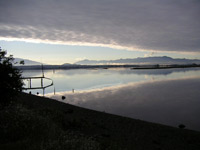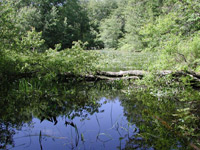|
Critical
Areas
Critical Areas are defined as wetlands, aquifer recharge areas,
flood hazard areas, geologically hazardous areas, and fish &
wildlife habitat conservation areas. Some of these areas are
critical because of the hazard they represent to public health
and others are critical because of their public value.
With the
exception of Activities Allowed Without Standard Review as listed
under SCC 14.24.100, any land-use activity that can impair the
functions and values of critical areas or their buffers through
a development activity or by disturbance of the soil or water,
and/or by removal of or damage to, existing vegetation requires
standard critical areas review and written authorization pursuant
to SCC 14.24.
Maps depicting
the National Wetland Inventory & hydric soils, Department
of Natural Resources stream type data, and potential geologic
hazards are available for viewing at the Planning & Permit
Center.
Critical
Area Forms and Checklists
Flood
Flood
Map(Pdf)
The Flood Damage Prevention Ordinance (SCC 14.34) was created
in order to promote health, safety and welfare for the users
of buildings within the floodplain and to minimize preventable
claims against the National Flood Insurance Program.
Flood
forms from Planning and Permit.
Forest Practices
Forest Practices are governed under RCW 76.09 (http://www.leg.wa.gov/RCW/index.cfm?fuseaction=chapterdigest&chapter=76.09)
They are also subject to compliance with the provisions of the
critical areas ordinance (SCC 14.24).
State Environmental Policy Act (SEPA)
SEPA provides a way to identify possible environmental impacts
that may result from governmental decisions. These decisions
may be related to issuing permits for private projects, constructing
public facilities, or adopting regulations, policies or plans.
www.ecy.wa.gov/programs/sea/sepa/e-review.html
When
SEPA review is required:
- Rezone:
be sure that Supplement D is attached and completed.
- Special
Use Permits: all except Administrative Special Uses.
- Shoreline
Permits: all but variances and exemptions.
- Amendments
to any codes/ordinances/plans which are more than procedural
changes.
- Construction
of more than 20 dwelling units
- Agricultural
buildings over 30,000 square feet in area
- Office,
school, commercial, recreational, service or storage buildings
over 12,000 square feet with associated parking facilities
designed for forty (40) automobiles.
- Construction
of a parking lot designed for 40 automobiles
- Fill
and/or grading 500 or more cubic yards.
- Proposed
land divisions for more than four (4) lots.
- Installation
of impervious underground tanks having a capacity greater
than 10,000 gallons.
There may
be other situations where an environmental
checklist will be required. The most common ones are listed
above. If you are unsure, please consult Planning and Permit
Center staff. Online
Environmental Checklist.
Septic
The code regulating On-Site Sewage Systems (OSS) is SCC 12.05.
To start the process of getting a septic permit, you need to
contact a certified septic designer (or professional engineer).
A list of certified designers, installers, and pumpers is available
at the Health Department.
System
Maintenance (Pdf)
Installers/Designers
(Pdf)
Drinking Water
The three most comment forms of obtaining a water supply are
connecting to a State Department of Health approved public water
system, connecting to a community well (County Health approved
public water system), and connecting to an individual well.
In order to drill a well, a licensed driller will first obtain
a permit from the State Department of Ecology.
Visit
the Skagit County Health Department Drinking Water Site.
Shorelines
The Shoreline Management Act (SMA) and the Skagit County Shoreline
Master Program (SMP) are based upon a recognition that shorelines
are limited resources and that these resources serve and support
a broad and diverse range of activity. The SMP was originally
adopted by the Skagit County Commissioners on June 29, 1976
and it received State approval on October 5, 1976. Amendments
have been made to the SMP, most recently on July 10, 1995. Currently,
Planning & Permit Center staff is developing an updated
shoreline inventory and we will be making additional amendments
to the regulations.
Shoreline
Master Plan Skagit County Code 14.26
Shorelines
of the State are listed in RCW 90.58 (http://apps.leg.wa.gov/RCW/default.aspx?cite=90.58
)
The shoreline
area designation map may be viewed at the Planning & Permit
Center.
Shoreline
Forms and information
|











